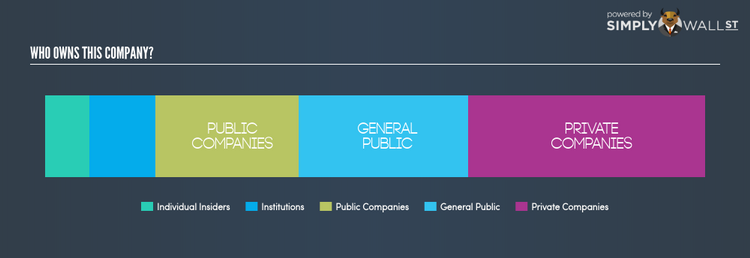What Does Alliance Resources Limited’s (ASX:AGS) Ownership Structure Look Like?

In this analysis, my focus will be on developing a perspective on Alliance Resources Limited’s (ASX:AGS) latest ownership structure, a less discussed, but important factor. A company’s ownership structure is often linked to its share performance in both the long- and short-term. Since the effect of an active institutional investor with a similar ownership as a passive pension-fund can be vastly different on a company’s corporate governance and accountability of shareholders, investors should take a closer look at AGS’s shareholder registry.
View our latest analysis for Alliance Resources
Institutional Ownership
In AGS’s case, institutional ownership stands at 10.02%, significant enough to cause considerable price moves in the case of large institutional transactions, especially when there is a low level of public shares available on the market to trade. These moves, at least in the short-term, are generally observed in an institutional ownership mix comprising of active stock pickers, in particular levered hedge funds, which can cause large price swings. In the case of AGS, investors need not worry about such volatility considering active hedge funds don’t have a significant stake. However, we should dig deeper into AGS’s ownership structure and find out how other key ownership classes can affect its investment profile.
Insider Ownership
Another important group of shareholders are company insiders. Insider ownership has to do more with how the company is managed and less to do with the direct impact of the magnitude of shares trading on the market. With 6.82% ownership, AGS insiders is an important ownership type. An insider stake of this level indicates that executives are highly aligned with the shareholders as both stand to gain when the value of the company rises. It may be interesting to see what insiders have been doing with their shares lately. Insiders buying shares can be a positive indicator of future performance, but a selling decision can be simply driven by personal financial needs.
General Public Ownership
A substantial ownership of 25.73% in AGS is held by the general public. With this size of ownership, retail investors can collectively play a role in major company policies that affect shareholders returns, including executive remuneration and the appointment of directors. They can also exercise the power to decline an acquisition or merger that may not improve profitability.
Private Company Ownership
Another group of owners that a potential investor in AGS should consider are private companies, with a stake of 35.77%. While they invest more often due to strategic interests, an investment can also be driven by capital gains through share price appreciation. An ownership of this size indicates a strong financial backing and has the potential to influence AGS’s business strategy. Thus, investors should dig deeper into AGS’s business relations with these companies and how it can affect shareholder returns in the long-term.
Next Steps:
The company’s high institutional ownership makes margin of safety a very important consideration to existing investors since long bull and bear trends often emerge when these big-ticket investors see a change in long-term potential of the company. This will enable shareholders to comfortably invest in the company while avoid getting trapped in a sustained sell-off that is often observed in stocks with this level of institutional participation. However, ownership structure should not be the only focus of your research when constructing an investment thesis around AGS. Rather, you should be examining fundamental factors such as Alliance Resources’s past track record and financial health. I highly recommend you to complete your research by taking a look at the following:
1. Financial Health: Is AGS’s operations financially sustainable? Balance sheets can be hard to analyze, which is why we’ve done it for you. Check out our financial health checks here.
2. Past Track Record: Has AGS been consistently performing well irrespective of the ups and downs in the market? Go into more detail in the past performance analysis and take a look at the free visual representations of AGS’s historicals for more clarity.
3. Other High-Performing Stocks: Are there other stocks that provide better prospects with proven track records? Explore our free list of these great stocks here.
NB: Figures in this article are calculated using data from the last twelve months, which refer to the 12-month period ending on the last date of the month the financial statement is dated. This may not be consistent with full year annual report figures.
To help readers see pass the short term volatility of the financial market, we aim to bring you a long-term focused research analysis purely driven by fundamental data. Note that our analysis does not factor in the latest price sensitive company announcements.
The author is an independent contributor and at the time of publication had no position in the stocks mentioned.


